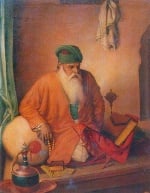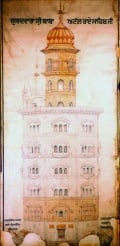Template:Did you know: Difference between revisions
From SikhiWiki
Jump to navigationJump to search
Hari singh (talk | contribs) No edit summary |
Hari singh (talk | contribs) No edit summary |
||
| Line 1: | Line 1: | ||
---- | ---- | ||
{{aowhy|[[Template:Did you know|Did you know...]]}}<div style="background-color:#FFFFEC;"> | {{aowhy|[[Template:Did you know|Did you know...]]}}<div style="background-color:#FFFFEC;"> | ||
[[Image:Mian Mir.jpg|150px|left|Hazrat Mian Mir]] | |||
*..... that '''Hazrat [[Mian Mir]]''' was a famous [[Muslim]] Sufi saint who is highly respected by the Sikhs. He was a close friend of the Sikh leader [[Guru Arjan Dev]], upon whose invitation he laid the foundation stone of the famous Sikh [[Golden Temple]] in [[Amritsar]] on 3 January 1588. | |||
*..... that the word [[Singh]] from [[Sanskrit]] '''sinha''' which means '''Lion''' and is an essential component of the name for a Sikh male. | |||
*..... that the [[Sikh]] concept of '''[[Sarbaht dah Phahla]]''' which means '''"Blessings for Everyone"''' or literally '''"May everyone Prosper"''' is a new concept for many people and is not common knowledge for many followers of the Sikh religion. | |||
*.....that '''[[Guru Ram Das]]''' ji was born at Chuna Mandi Bazaar, [[Lahore]] on 24th September 1534 and spent the first seven years of his life here and that his name before obtaining Guruship was '''Bhai Jetha''' which means '''the first born'''. | |||
[[Image:Dukh Nivaran 01.jpg|thumb|200px|right|{{cs|'''Gurdwara Dukh Nivaran Sahib Patiala'''}}]] | |||
*..... that [[Gurdwara Dukh Nivaran Sahib Patiala]] marks the place where [[Guru Tegh Bahadur]] visited village Lehal on 24 January 1672 and stayed under a banyan tree by the side of a pond. Soon the sickness in the village subsided. The site where the Guru had sat came to be known as ''"Dukh Nivaran"'' literally meaning ''Eradicator of suffering''. | |||
*....that on 10 October, 1982, a '''[[National Protest by UK Sikhs]]''' was organised to highlight and demand the right of children to go to school wearing their [[turban]]s. | |||
*.... that the tercentenary celebration of the [[Guruship]] of [[Sri Guru Granth Sahib]] is to be undertaken on a massive scale in October 2008 at [[Hazoor Sahib|Takhat Sachkhand Shri Hazur Abchalnagar Sahib]] in [[Nanded]], [[Maharashtra]], [[India]]. | |||
*.....that one of the '''five forts''' in [[Anandpur Sahib]] built by [[Guru Gobind Singh]] was called '''[[Keshgarh Fort]]'''. | |||
*.....that '''[[Guru Ram Das]]''' ji was born at Chuna Mandi Bazaar, [[Lahore]] on 24th September 1534 and spent the first seven years of his life here and that his name before obtaining Guruship was '''Bhai Jetha''' which means '''the first born'''. | |||
[[Image:Baba atal tower.jpg|thumb|left|120px|Gurdwara Baba Atal Rai Sahib]] | [[Image:Baba atal tower.jpg|thumb|left|120px|Gurdwara Baba Atal Rai Sahib]] | ||
| Line 10: | Line 31: | ||
* .... that '''[[Sant Prem Singh]]''' (1882 - 1950) was an important social, political and religious leader who was a visionary and a social reformer and that he worked for [[Sikhism]] through [[Amrit Sanchaar]] and played important role for the uplift of the [[Lobana]] community..... | * .... that '''[[Sant Prem Singh]]''' (1882 - 1950) was an important social, political and religious leader who was a visionary and a social reformer and that he worked for [[Sikhism]] through [[Amrit Sanchaar]] and played important role for the uplift of the [[Lobana]] community..... | ||
<!----------------------------------Disabled ----------------------- | |||
[[Image:Dhannabhagat.jpg|thumb|150px|right|Gurdwara Bhagat Dhanna]] | [[Image:Dhannabhagat.jpg|thumb|150px|right|Gurdwara Bhagat Dhanna]] | ||
* .... that [[Gurudwara Bhagat Dhanna]] was constructed by Sant Baba Shisha Singh to facilitate devotees on their travels to and from the city the world knows as [[Nanded]]. Sikhs call the city Abichalnagar as the city is sacred to the memory of [[Guru Gobind Singh]] who left for his heavenly abode there.... | * .... that [[Gurudwara Bhagat Dhanna]] was constructed by Sant Baba Shisha Singh to facilitate devotees on their travels to and from the city the world knows as [[Nanded]]. Sikhs call the city Abichalnagar as the city is sacred to the memory of [[Guru Gobind Singh]] who left for his heavenly abode there.... | ||
| Line 20: | Line 41: | ||
* ... that [[Tarna Dal]], the army of the youth, was one of the two main divisions of [[Dal Khalsa]], the confederated army of the [[Sikh]]s during the eighteenth century, the other one being the [[Buddha Dal]] (army of the elders).... | * ... that [[Tarna Dal]], the army of the youth, was one of the two main divisions of [[Dal Khalsa]], the confederated army of the [[Sikh]]s during the eighteenth century, the other one being the [[Buddha Dal]] (army of the elders).... | ||
* .... that '''[[Bhai Jivan Singh]]''' (1649-1705) was the name given to Bhai Jaita after he had received the [[Amrit Sanskar|rites of initiation]] at the hands of [[Guru Gobind Singh]] on the day - [[Baisakhi|30 March 1699]] when the [[Khalsa]] was inaugurated.... | * .... that '''[[Bhai Jivan Singh]]''' (1649-1705) was the name given to Bhai Jaita after he had received the [[Amrit Sanskar|rites of initiation]] at the hands of [[Guru Gobind Singh]] on the day - [[Baisakhi|30 March 1699]] when the [[Khalsa]] was inaugurated.... | ||
| Line 134: | Line 155: | ||
.....that the word '''[[Ardas]]''' is derived from the Persian word 'Arazdashat', meaning '''a request''', a '''supplication''', a '''prayer''', a '''petition''' or '''an address to a superior authority'''. | .....that the word '''[[Ardas]]''' is derived from the Persian word 'Arazdashat', meaning '''a request''', a '''supplication''', a '''prayer''', a '''petition''' or '''an address to a superior authority'''. | ||
[[Image:DamdamaSahib1.jpg|thumb|150px|right|Sri Damdama Sahib]] | [[Image:DamdamaSahib1.jpg|thumb|150px|right|Sri Damdama Sahib]] | ||
Revision as of 21:42, 21 June 2008
Did you know...
- ..... that Hazrat Mian Mir was a famous Muslim Sufi saint who is highly respected by the Sikhs. He was a close friend of the Sikh leader Guru Arjan Dev, upon whose invitation he laid the foundation stone of the famous Sikh Golden Temple in Amritsar on 3 January 1588.
- ..... that the word Singh from Sanskrit sinha which means Lion and is an essential component of the name for a Sikh male.
- ..... that the Sikh concept of Sarbaht dah Phahla which means "Blessings for Everyone" or literally "May everyone Prosper" is a new concept for many people and is not common knowledge for many followers of the Sikh religion.
- .....that Guru Ram Das ji was born at Chuna Mandi Bazaar, Lahore on 24th September 1534 and spent the first seven years of his life here and that his name before obtaining Guruship was Bhai Jetha which means the first born.
- ..... that Gurdwara Dukh Nivaran Sahib Patiala marks the place where Guru Tegh Bahadur visited village Lehal on 24 January 1672 and stayed under a banyan tree by the side of a pond. Soon the sickness in the village subsided. The site where the Guru had sat came to be known as "Dukh Nivaran" literally meaning Eradicator of suffering.
- ....that on 10 October, 1982, a National Protest by UK Sikhs was organised to highlight and demand the right of children to go to school wearing their turbans.
- .... that the tercentenary celebration of the Guruship of Sri Guru Granth Sahib is to be undertaken on a massive scale in October 2008 at Takhat Sachkhand Shri Hazur Abchalnagar Sahib in Nanded, Maharashtra, India.
- .....that one of the five forts in Anandpur Sahib built by Guru Gobind Singh was called Keshgarh Fort.
- .....that Guru Ram Das ji was born at Chuna Mandi Bazaar, Lahore on 24th September 1534 and spent the first seven years of his life here and that his name before obtaining Guruship was Bhai Jetha which means the first born.
- .... that Baba Atal Rai was born in 1619 AD at Amritsar to Guru Hargobind Sahib, the sixth Sikh Guru and Mata Mahadevi, daughter of Bhai Daya Ram Marwah of Mandeala.....
- ....that Guru Gobind Singh had four adopted sons and the one of them was also called Zoravar Singh Palit - (palit means adopted). These four adopted sons were Baba Charan Singh, Baba Punjab Singh, Baba Ajaipal Singh and of course, Baba Zoravar Singh Palit.
- .... that the ninth Guru, Guru Tegh Bahadur on his way to Patna in east India visited Agra. A devout Sikh disciple lady invited Guru Tegh Bahadur to her house where he stayed for a day or two. Her name was Mai Jassi. The site of house has become a shrine and is known as Gurudwara Mai Than, Agra....
- .... that Sant Prem Singh (1882 - 1950) was an important social, political and religious leader who was a visionary and a social reformer and that he worked for Sikhism through Amrit Sanchaar and played important role for the uplift of the Lobana community.....



